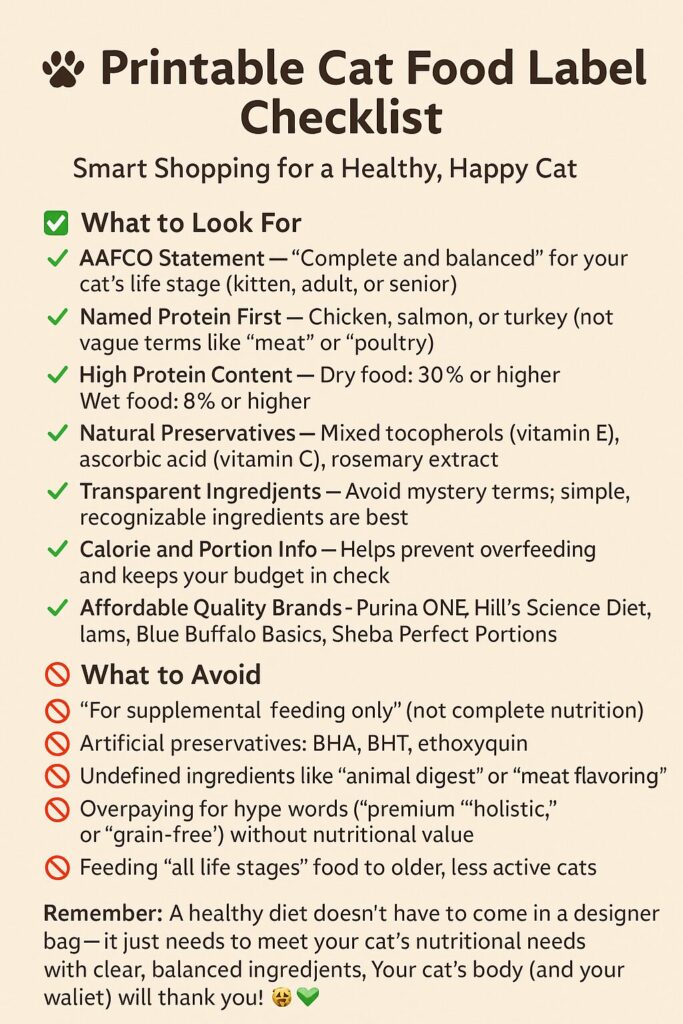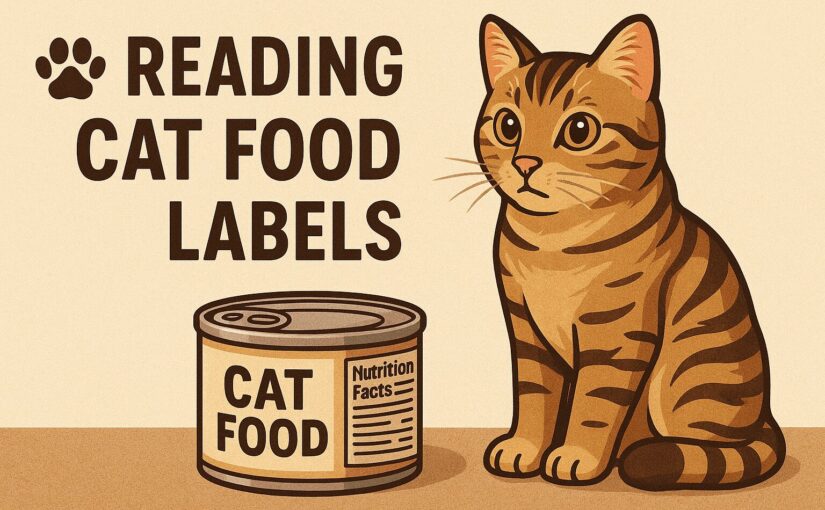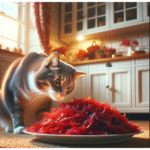If you’ve ever stood in the pet food aisle feeling like you need a decoder ring to understand what’s actually in your cat’s food, you’re not alone. Cat food labels can be confusing — full of buzzwords, fine print, and nutritional jargon. But once you know what to look for, you can make confident, informed choices that support your cat’s health and your wallet.
Let’s walk through the label line by line and uncover how to get the best value without compromising on quality.
1. Start with the AAFCO Statement
The very first thing to look for on any cat food label is the AAFCO nutritional adequacy statement.
AAFCO (the Association of American Feed Control Officials) sets basic standards for pet food nutrition. If the package says something like:
“Formulated to meet the nutritional levels established by the AAFCO Cat Food Nutrient Profiles for adult maintenance”
—that means the food meets the minimum requirements for a complete and balanced diet for adult cats.
If it says “for all life stages” or “for growth and reproduction”, it’s richer in calories and nutrients — great for kittens or pregnant/nursing cats, but too rich for many adult cats long term.
✅ Budget tip: Avoid foods that don’t carry the AAFCO statement; they may be “treats” or “supplements” and not nutritionally complete.
2. Decode the Ingredients List
Ingredients are listed by weight, from most to least. But here’s the catch: ingredients with high water content (like “chicken” or “salmon”) weigh more than dry ingredients such as grains or meal powders — even if there’s less actual protein in them.
So, a food that lists “chicken” first might not be higher in protein than one that lists “chicken meal” first.
Here’s what to look for:
- 🐔 Named meats first: “Chicken,” “turkey,” or “salmon” are good. “Poultry,” “meat,” or “fish” (without specifics) are vague catch-alls.
- 🍗 Meal vs. by-product:
- Chicken meal is a concentrated protein powder — actually quite nutritious.
- By-products can vary from nutritious organ meats to less desirable parts.
- 🚫 Avoid fillers and vague ingredients: “Animal digest,” “meat flavoring,” or “corn gluten meal” add little nutritional value.
✅ Budget tip: Don’t shy away from “chicken meal” or “turkey meal.” They’re often more protein-dense — and more affordable — than fresh meat formulas.
3. Understand the Guaranteed Analysis
This section lists the minimum or maximum percentages of nutrients like protein, fat, fiber, and moisture.
Here’s what a typical label might show:
| Nutrient | Minimum/Maximum | Why It Matters |
|---|---|---|
| Crude Protein | 32% min | Essential for muscle and tissue health |
| Crude Fat | 15% min | Source of energy and fatty acids |
| Crude Fiber | 3% max | Aids digestion — too much can reduce nutrient absorption |
| Moisture | 10% max (dry food) | Affects actual nutrient density |
To compare dry vs. wet foods fairly, you can calculate the “dry matter basis” — but for everyday purposes, look for:
- ≥30% protein in dry food
- ≥8% protein in canned food (which has high moisture content)
✅ Budget tip: Store brands that list similar protein and fat ratios to premium brands often perform just as well for healthy adult cats. Check the analysis — not just the price tag.
4. Beware of Marketing Buzzwords
Labels love to use words like “natural,” “holistic,” “premium,” and “grain-free.”
Here’s what those really mean:
- Natural: Minimally processed, but preservatives like mixed tocopherols (vitamin E) are allowed.
- Grain-free: Doesn’t necessarily mean healthier — it might replace grains with peas, lentils, or potatoes, which aren’t always better.
- Human-grade: Must be made in a facility that meets human food standards (good, but pricier).
- No by-products: Sounds great, but removes organ meats that can be valuable sources of nutrition.
✅ Budget tip: Focus on nutrient content over marketing claims. A mid-range “complete and balanced” brand often outperforms pricey boutique foods with fancy packaging.
5. Check the Nutritional Purpose and Feeding Directions
Every label must specify who the food is for: kittens, adults, seniors, or “all life stages.” Feeding an “all life stages” formula to an older cat may lead to unnecessary weight gain.
Feeding guidelines are just starting points — your cat’s actual needs vary by age, activity level, and metabolism.
✅ Budget tip: Overfeeding wastes money and can harm your cat’s health. Measure portions carefully, and ask your vet what calorie range is right for your cat’s size.
6. Understand Additives and Preservatives
Look for natural preservatives such as:
- Mixed tocopherols (vitamin E)
- Ascorbic acid (vitamin C)
- Rosemary extract
Avoid artificial ones like BHA, BHT, or ethoxyquin, which are controversial and largely phased out of reputable brands.
✅ Budget tip: Many moderately priced foods now use natural preservatives — check the ingredient list instead of assuming you need to “go premium.”
7. Compare Price by Nutrient, Not by Bag Size
That $50 bag might not be as expensive as it looks if it’s more calorie-dense and lasts longer.
Use the cost-per-day method:
- Check feeding directions (cups per day).
- Multiply by your cat’s needs.
- Compare how many days the bag will last.
✅ Budget tip: Buying larger bags can lower cost per pound — but only if you can keep it fresh. Store in an airtight container in a cool, dry place.
8. Brands That Balance Quality and Affordability
While preferences and availability vary, some brands consistently perform well in independent reviews for nutritional quality and safety without breaking the bank:
- Purina ONE or Purina Pro Plan
- Iams Proactive Health
- Hill’s Science Diet (especially on sale or via autoship)
- Blue Buffalo Basics
- Sheba Perfect Portions (for wet food fans)
Always check for recall history and the AAFCO statement before switching.
9. When in Doubt, Ask Your Vet
Your veterinarian (or a veterinary nutritionist) can help interpret labels and recommend specific nutrient ranges for your cat’s needs — whether they’re overweight, senior, or managing a health condition.
If your cat needs a prescription diet, ask if there’s a nutritionally equivalent over-the-counter option for maintenance once the condition stabilizes.
Final Thoughts
Understanding cat food labels isn’t about memorizing every term — it’s about recognizing what truly matters:
✅ Complete and balanced nutrition
✅ High-quality protein sources
✅ Transparent ingredient lists
✅ Sensible feeding amounts
When you focus on these fundamentals, you can confidently choose a diet that fits both your cat’s health needs and your household budget.
After all, a healthy cat — and a happy wallet — are both worth purring about. 🐾







